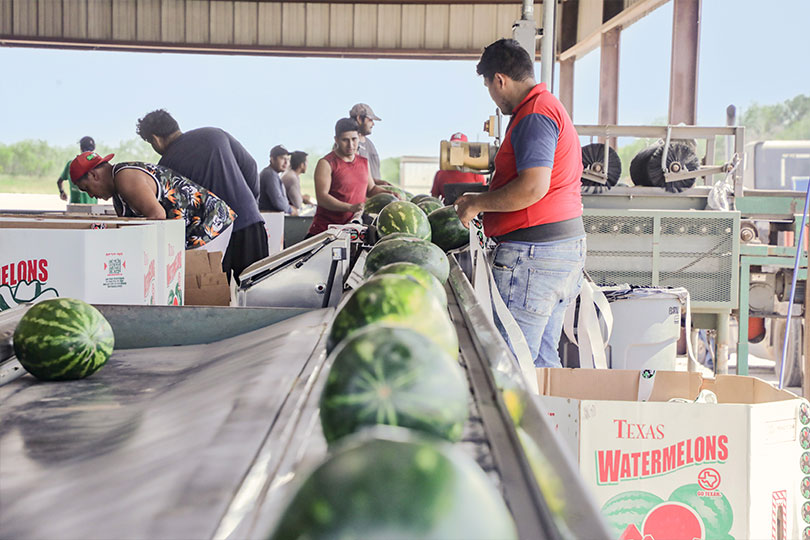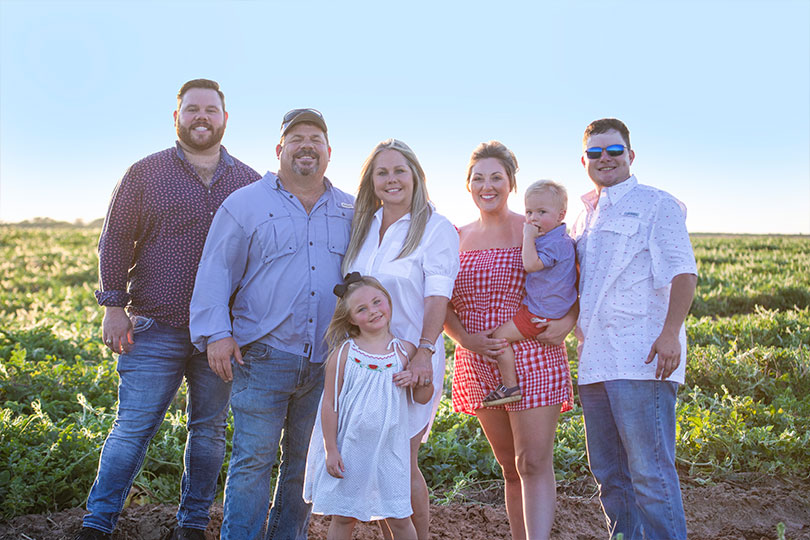By Shelby Shank
Field Editor
Childhood memories are filled with watermelons for Darren Wiggins.
He remembers running through the fields and eating the sweet slices of watermelon all summer long, and now he grows the melons in the Rio Grande Valley.
“I just grew up farming. It’s something that when we were little kids, just big enough to walk, we were in the watermelon fields,” Darren, a third-generation farmer, said. “My family has been growing watermelons for forever. It started with my great-granddad, my granddad, my father, and I followed in their footsteps.”
In 2000, Darren moved his family from East Texas to the Valley and begin growing his own watermelons at Wiggins Farms.
He grows 800 acres of watermelons in Willacy County between Lasara and Dilley, working alongside his sons Jared and Jesse.
“We farm other commodities, but watermelon is my happy commodity,” Darren said. “Watermelon makes you smile, makes kids smile. It’s a treat.”
Growing watermelons
They prepare the soil in October. Seeds are planted the last week of December in the greenhouse and then planted in the ground at the beginning of February.
After being transplanted from the greenhouse and into the ground, it takes 75 to 85 days for the melons to be ready for harvest, which begins in May and concludes in October or November—depending on the weather.
Watermelons need plenty of sun and water to help them grow. Darren noted it’s also important for watermelons to be covered by vines and leaves to protect them from getting sunburned.
Growing watermelons does come with challenges, though.
“Disease is probably the biggest challenge we face. Fusarium wilt is a bad one that can take out a field of watermelons,” Darren said. “Downey mildew and powdery mildew are airborne diseases that can take the crop out. Worms are a big issue, but white fly here in the Valley is a real big issue.”
Weather is also a challenge. Too much rain can be devastating to the crop.
“Last year, we had three inches of rain while we were growing the crop. And this year, we’ve probably had 11 inches of rain growing the crop. It’s harder to make melons in wet weather,” he said. “They’re a desert crop. So, the wetter it is, the harder it is to make good quality melons.”
Sandy and well-drained soil is best for growing watermelons. Darren uses drip irrigation and fertilizes his watermelons every 14 to 21 days with fungicide or insecticide to keep the melons free from disease.
Labor of love
Planting and harvesting watermelons is a labor-intensive job.
“It’s all done by manual labor. We have cutters that go through and cut the watermelons from the vine prior to another group of people coming through and picking up the watermelons to place in field trucks,” he said. “Then, we haul the watermelons from the field to the shed where they are packed in boxes and sent off to the grocery stores. A good crew makes it easy.”
Darren employs about 80 people during harvest to cut, pick and pack.
Wiggins Farms harvests 35 to 40 million pounds of watermelons a year. They can be found in stores as far as Canada or as close as the neighborhood grocery store.

Finding the perfect watermelon
When shopping for watermelons, Darren said there are a few tips to find just the right one.
“For me, it’s easy because I’m used to looking at them. Generally, a good watermelon is going to have a stained belly from sitting on the earth,” he said. “It’s going to have a stained belly and a little wider stripe. The further apart the stripe is generally the more mature the melon is. But the belly is the best indicator of a good watermelon.”
A yellow belly or a yellow stain on a watermelon means it is mature. When watermelons are finished growing, they start getting mature. The soil stains the watermelon while it sits and matures.
“You can look at a watermelon two different ways. A watermelon is either light green with a dark stripe or a watermelon is dark green with with a light stripe,” he said. “Is a zebra black and white or white and black? Watermelons are the same way, but the further apart the dominant stripe is, the more mature the melon is.”
A family legacy
Each year, Darren prepares the land, plants the seeds, nurtures the soil and grows the crop with a little extra faith, hope and love. And it’s rewarding to farm alongside his sons and wife.
“I’ve always had my heart and soul set on doing what my father did—growing watermelons,” Jared, the youngest son, said.
Jesse also takes pride in sharing his family’s story in growing watermelons and hopes to continue that tradition in the future.
Farming with family isn’t without its challenges, but it’s a lifestyle the Wiggins family cherishes. And it brings them joy to see other families making memories around the watermelons grown at Wiggins Farms.
“The most rewarding thing about growing watermelons is getting up in the morning and seeing the social media post about people happy with a watermelon at the beach or a birthday party or a family event,” Darren said.
Seeing families enjoying the sweet taste of summer with every slice of watermelon—that’s why the Wiggins family takes such pride in growing them. And will continue to do so for years to come.


Watermelon is my favorite fruit. But here in Florida it’s hard to find a good one I read your article and take your advice on how to pick a watermelon thank you for your hard work